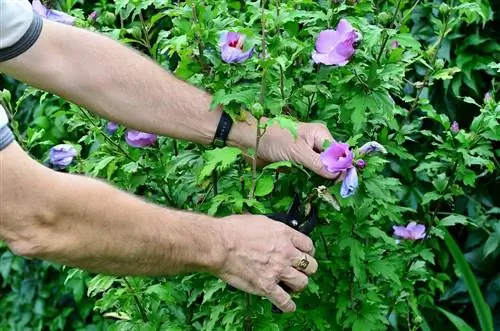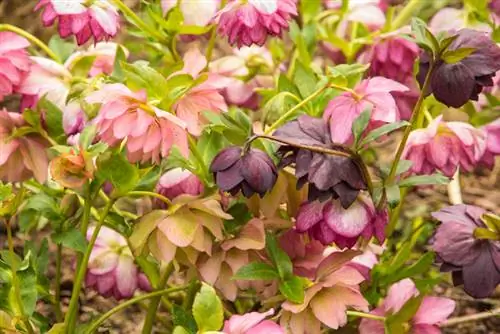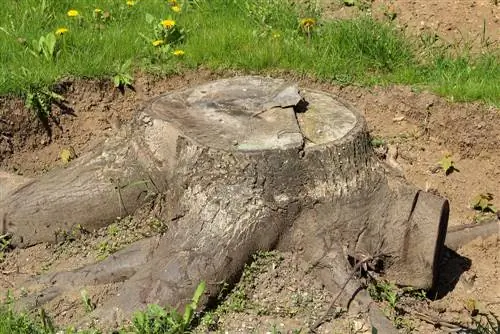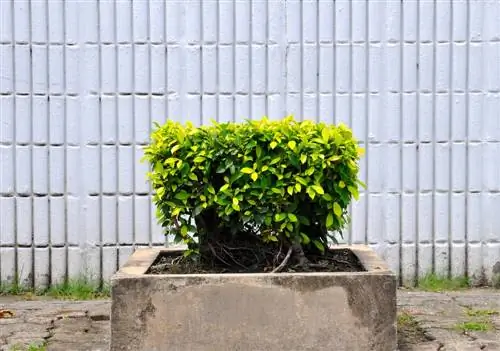- Author admin [email protected].
- Public 2023-12-24 06:09.
- Last modified 2025-06-01 06:02.
The yew is a conifer of superlatives. Pronounced shade tolerance, extremely slow growth, biblical longevity and exceptionalcutting tolerance have earned the conifer the title of Tree of the Year. Due to its significant toxicity, the yew was named poisonous plant of the year in 2011. If you like the positive properties and are not put off by the toxic ingredients, the yew will enrich your garden as an impressive solitaire, evergreen sculpture, decorative border or opaque hedge. This tutorial explains in detail how to properly approach pruning care.
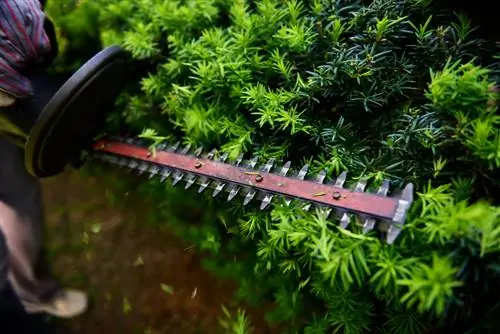
How to cut the yew tree?
Cut the yew tree into different shapes. It sprouts again from the old wood. Shorten the yew tree in stages so that it does not grow too wide or too high. The wood is very hard. You need professional cutting tools. Attention, the yew is a poisonous plant.
Eibe cooperates with all types of cuts - options and dates at a glance
The legendary adaptability of a yew tree culminates in the fact that it is the only garden coniferfrom old wood to sprout again. This applies equally to the native European yew (Taxus baccata), the cup yew (Taxus media) and all varieties resulting from them. A colorful array of representative cutting shapes for small and large gardens invites home gardeners to come up with creative design ideas. The following table presents all options with recommended cutting times:
| Cut style | Goal/Occasion | best date | alternative or additional appointment |
|---|---|---|---|
| Educational Cut Solitaire | dense, bushy, harmonious growth | End of February/beginning of March | End of June to mid-July |
| Preservation cut solitaire | if necessary to maintain shape, remove dead wood | End of February/beginning of March | End of June to mid-July |
| Rejuvenation Solitaire | Downsizing or revitalization | February to March 1st | none |
| Plant cutting hedge | strong branching at the base | after planting | February of the following year |
| Build-up cut hedge | densely needled hedge in trapezoid shape | February | End of June (St. John's Day) |
| Shape and care cut | maintain a well-groomed appearance | End of June to mid-July | Mid to late August |
| Rejuvenation hedge | revitalizing neglected, outdated hedges | February to March 1st | none |
Green garden monument for eternity - this is how you raise a yew tree as a solitaire
We don't know whether Germany's oldest yew tree has reached its proud age of 1.000 to 1,400 years thanks to a skillful upbringing. The fact is that the conifer gainsstability and beauty if it is given moderate pruning when it is young. Are you thinking about integrating a yew tree into your garden design as a solitary eye-catcher? Then we recommend the following, gradual pattern training:
- Build yew as a solitary plant with a maximum of 3 dominant, vertical scaffolding shoots
- Excess steep shoots divert every few years to a short, needle-covered side shoot in the lower half of the shoot
- You can either divert branches that are too long, curved or cut them into short cones
A yew tree with more than 3 upright scaffold shoots develops an uneven habit that is prone to wind breakage. Over time you will have to complain about shoot tips falling apart. In addition, the outer, densely needle-covered scaffold shoots shade the interior of the plant, so that baldness spreads here. Follow our recommendation for training with 3 dominant scaffold shoots, which are surrounded by shorter side shoots, to give your yew tree a harmonious and stable shape as a solitary plant.
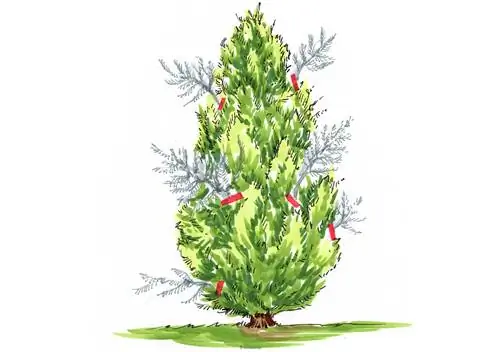
Grow a solitary yew tree with three vertical scaffolding shoots. Additional scaffolding shoots affect stability if they thrive at the same height. These are redirected to shorter side shoots. Shorten excessively long shoots to short cones.
Background
Activation of sleeping eyes causes yew to fall out of old wood
For most deciduous trees it is a given, but among conifers it is a sensation. We are talking about the ability of a yew tree to sprout again after vigorous to radical pruning. Yews are the only coniferous species to develop sleeping eyes as they grow. Specifically, they are almost invisible buds that have a single task. If branches, twigs or the entire trunk fall victim to storm damage or radical cutting, the dormant vegetation points are activated. The resulting growth replaces the lost parts of the plant and closes any gaps within the bush or crown.
This is how an occasional pruning keeps your yew tree in perfect shape
A yew tree at its best does not need annual pruning. Shortening cheeky branches that protrude from the shape is beneficial for the well-groomed appearance. As the illustration below illustrates, yew branches that are too long are cut back to a short side shoot. Thanks to this cutting technique, there are no unsightly gaps in the needle dress. Thin out dead wood to short cones. The best time for occasional maintenance pruning is in February, shortly before fresh shoots begin.
Take action in time if your yew tree gets too tall. A cut solitaire loses its natural growth habit for many years. Instead, devote yourself to the longest scaffold shoot with a lead cut. Choose a promising side shoot in the lower half of the branch. Whereboth shoots fork, cut off the branch that is too long. In the following years, your yew will sprout several young branches at the intersection. Choose the most promising candidate as the new top and remove the remaining shoots.
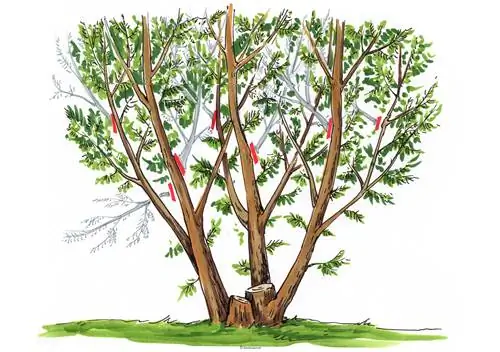
In its natural form, the yew tree grows as a multi-stemmed shrub that does not require annual pruning. If necessary, you can use a derivation cut to bring cheeky branches into line and clear out dead wood.
Rejuvenate old yew trees in stages - this is how it works
The most common reason for rejuvenation pruning is when an old yew exceeds the space capacity in width and height. What is impossible with thuja, fir and other conifers, yews tolerate with good-natured pruning tolerance. The most important premise for a successful course is astep-by-step procedure How to do it right:
- The best time for each cutting stage is in late winter
- Every year cut back a quarter of the longest side shoots on the three vertical scaffold shoots
- Short side branches to a 2 cm short peg on the main shoot
- Strong-growing shoots that compete with the three scaffold shoots are diverted to a lower side branch
Once you have cut all the side branches on the scaffold back to short tenons, devote the last year to regulating the height. Don't just trim the vertical scaffolding shoots anywhere to the desired height. Choose a branch as the starting point for the cut. Place the pruning shears about 2 centimeters behind the fork between the old and young shoots. As a result, the yew tree is shorter without the horticultural intervention being visible. The image below shows the correct procedure.
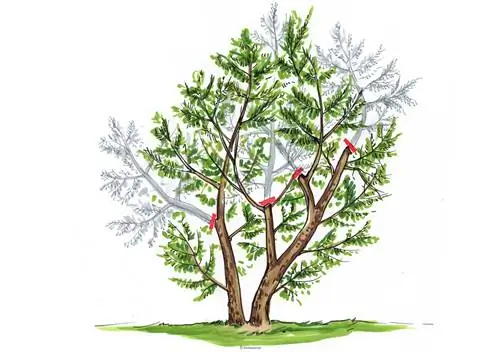
If the yew tree grows over your head, a rejuvenation cut will solve the problem. A gradual shortening is advantageous. Every late winter, cut back a quarter of the side branches along the dominant, vertical scaffold shoots to short cones. Last year you reduce the height growth by cutting the branch tips.
Excursus
Hard yew wood requires resilient cutting tools
Very slow growth results in one of thehardest woods in the realm of trees and shrubs. When it comes to cutting care, this means that only high-quality scissors and saws can handle yew wood. For cutting individual shoots up to 2 centimeters in diameter, the anvil one-handed shears come into focus because they work with optimized power transmission. To cut through branches 2 to 4 centimeters thick smoothly and effortlessly, we recommend two-handed pruning shears with a ratchet gear in brand quality. For artistic topiary cutting of yew sculptures, quality cordless shrub shears are a good choice. You can carry out fine work precisely with sturdy rose or sheep scissors. If you plan to care for a yew bed border, you should have two-handed hedge trimmers handy. You can carry out large-area hedge trimming accurately and time-savingly with a premium quality electric hedge trimmer.
Tip
Whenever you cut your yew tree, please consider the high poison content in shoots, needles and seeds. Protect yourself from the toxic plant sap with gloves, safety glasses and long-sleeved clothing. Do not throw the clippings into the compost or on pastures. Horses, cows, sheep and other grazing animals had to pay a painful death for eating yew branches because careless farmers disposed of the clippings on meadows.
Cutting the yew hedge on planting day - instructions for the perfect planting cut
Traditionally, the yew is at the top of the green wish list when gardeners want to create a long-lasting and easy-care hedge. Whether as an ankle-high bed border, a representative grave border, an evergreen room divider or a majestic privacy hedge. Yew trees always look good as a hedge if pruning care begins on the day of planting. To ensure that the conifers branch bushily from the base to the tip, this planting cut is advisable:
- The best time is immediately after planting in spring
- The younger the yew trees, the stronger the plant cut
- Prune young trees up to 30 cm high by a third or half
- Cut back taller hedge plants by 5 to 10 cm at the top and a third at the sides
Following the planting cut, sprinkle 100 grams of horn shavings per linear meter of hedge onto the plant strip and water generously. Now spread a thin layer of bark mulch to protect the soil from drying out.
Background
Pruning directs sap pressure to buds that would otherwise go empty
Slow growth alone is not enough for a yew hedge to have rich branches at the base. As a yew tree grows, it strives with all its might towards the light. The conifer therefore follows the growth law of top promotion. A large part of the reserve substances is transported to the tip buds under pressure. Lower buds have to make do with what's left. The greater the distance between a bud and the shoot tip, the greater the risk that it will end up completely empty and not sprout. With a planting cut the yew will be taught better. Since the top buds have to give way, the sap pressure is redistributed. Previously secondary buds at the base of the plant are the new top buds and benefit from a rich supply of nutrients. The growth effect as a result of the plant pruning is permanent, so that your freshly planted yew hedge will now thrive with a densely branched base.
Treating a yew hedge in a trapezoid shape - this is how you do it right
Gardening newcomers tend to let the new yew hedge grow uncut. Given the slow growth, every inch of growth should actually be welcomed with joy. Please do not allow yourself to be misled into this fallacy. Your yew hedge will meet your high expectations in the long term if you build up the conifers gradually. This is how you get the perfect build-up cut:
- The best time is in late winter until the desired final height is reached
- Optionally blend a second time around St. John's Day (June 24th)
- Stretch the cords as a guide for the straight cut inTrapezoid shape
- Cut back thelast year's growth to 5 or 10 centimeters
- When cutting in summer, cut this year'sgrowth by half
Proceed in this way until your yew hedge has reached the desired height. If you increase the size of the hedge by a maximum of 10 centimeters each year, there will be enough growth power available for vital, densely bushy branching in all areas. A light trapezoid shape is advantageous for the dense needlework. Hedges with a wide base and a narrow crown thrive in light because the branches do not overshadow each other. For this reason, shoots inside the hedge can also carry out photosynthesis and encourage leaf buds to sprout.
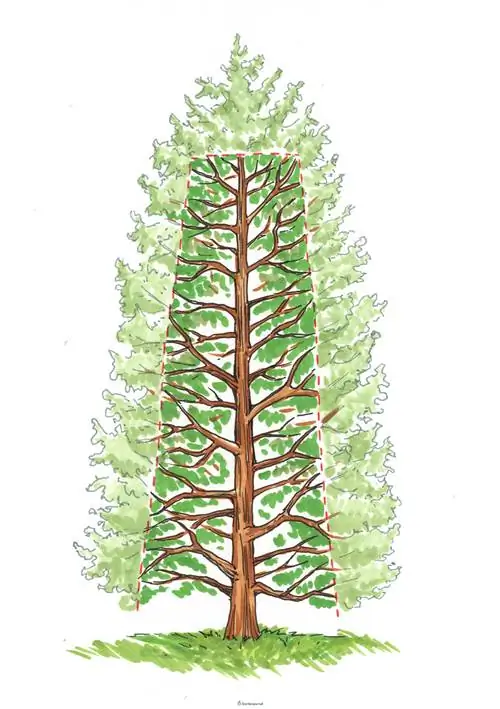
Always train conifer hedges in a light-flooded trapezoid shape. With a wide base and narrow crown, your yew branches cannot shade each other and have a dense coat of needles.
Summer care pruning preserves a well-groomed hedge appearance
A yew hedge at its final height usually copes well with annual maintenance pruning. The best time is the end of June. If necessary, trim the hedge one last time this year in mid-August to slow growth. The conifers hardly sprout afterwards, so you can look forward to an immaculately maintained hedge well into the winter. This is what you should pay attention to when making a care cut:
- On a large hedgeMarking cords Stretch for a conical cutting profile
- Cut hedge sides and flanks with a view to the uncut area
- Motor-operated knife bars withstretched arms swing back and forth
- When cutting with manual or electric hedge trimmers, start as close as possible to the previous cuts
You can prevent dents and waves in the cutting pattern if you operate a motorized hedge trimmer with your arms stretched out. Move the device back and forth from your shoulders on the sides and flanks. Ideally, you cut the hedge crown out of the back using pivoting movements.
Rejuvenate yew hedges gradually - this is how it works
You can successfully rejuvenate an over-aged, old or misshapen yew hedge if you proceed instages. As the figure below illustrates, you should allow at least 3 years for the measure. This is how the plan works:
- The best time for each stage is in late winter until March 1st (according to the Federal Nature Conservation Act)
- First year: cut back one side of the hedge and one flank except for short tenons on the scaffolding
- Second year: Cut back the hedge crown to 50 cm below the targeted final height
- Third year: trim the second side of the hedge with the flank except for small shoot stubs on the scaffolding
The successive approach means that after each radial cut, a sufficient volume of needles remains for the formation of reserve substances that stimulate fresh growth. In the fourth year after the start of rejuvenation, pruning care culminates in a gradual build-up as explained in this tutorial.
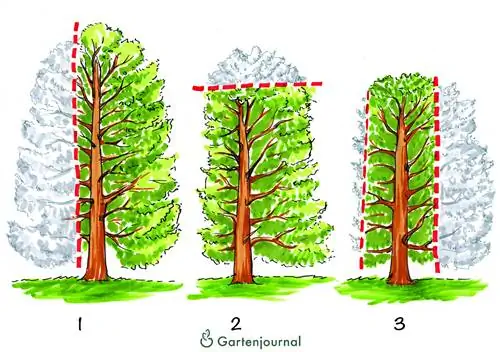
To rejuvenate an old yew hedge, proceed step by step. In the first year, cut one side down to short tenons on the framework. In the second year, devote some serious pruning to the top of the hedge. In the third year, the rejuvenation of the second side of the hedge is on the cutting plan.
Background
A look at the calendar gives the green light for the rejuvenation cut - or not
When rejuvenating yew hedges, protecting birds is a priority. The priority of feathered garden residents is expressed in Section 39 of the Federal Nature Conservation Act. It states that radical cuts on all types of trees are limited to the period from October 1st to February 28th. This applies equally to measures such as thinning, putting on the stick and rejuvenating. Before you devote yourself to revitalizing your yew hedge, please take a look at the calendar. Scissors and saws should rest during the grace period from March 1st to September 30th. Old yew trees can wait until winter. This waiting period does not exist for a young bird family in dense branches.
Frequently asked questions
I would like to grow a columnar yew tree in a pot on the terrace. What pot size is recommended if I start with an 80 cm tall plant? Do the roots adapt or does the pot have to grow with it?
The yew variety Taxus baccata 'Fastigiata Robusta' is ideal for keeping in containers. Please use a pot that is 20 to 25 centimeters larger in diameter than the delivery container or root ball. Over the years, the substrate becomes very solid and requires large amounts of irrigation water. This is a signal that the soil and pot are completely rooted through the root ball. In this case, please repot the yew into a larger pot. The best time is between October and March, when the conifer is at rest.
We would like to surround our terrace (natural stone slabs with a gravel bed) with a 100 to 150 cm high hedge. Is the 'Hillii' edging yew suitable for this or is there a risk that root strands will lift the terrace slabs?
Yew trees thrive as shallow-rooted trees. Deep roots only form in sandy soil. Over time, it may well happen that your patio slabs are raised slightly by a yew hedge. You can effectively prevent damage by placing lawn curbs between the terrace and the hedge that reach a depth of at least 40 centimeters. We also recommend a planting distance of 50 centimeters from the curbs.
How small can a border hedge with yew trees be kept?
If you use varieties for hedge planting, such as Taxus media 'Hillii' (without poisonous cones) or 'Hicksii' (with poisonous, red-fleshed cones), a height of 30 to 40 centimeters is quite realistic. This is possible thanks to the robust pruning tolerance of all yew species and varieties. If you cut in February and again on St. John's Day at the end of June, the border will remain at the desired height.
When is the best time to trim a freshly planted yew hedge? The long side shoots of the young plants intertwine. Should the yew trees also be cut in the middle where the branches of neighboring plants cross?
Ideally, you should carry out the planting cut on the day of planting. You can carry out subsequent topiary cuts several times a year. It is important to note that you do not cut in frost, extreme heat or summer drought. The planting cut on a young yew hedge concentrates on the outer area, the so-called “coat”. The spaces in between are spared from pruning. Interlocking, long shoots are desirable for dense, opaque growth.
I would like to arrange some splashes of color on the root disk of my yew trees. Which plants are recommended as underplanting?
The yew tree roots intensively through the topsoil with its shallow root system. At the same time, yews thrive primarily in low-light locations with fresh to moist soil. Consequently, underplanting has to be tough. Hostas (Hosta) are the ideal candidates as floral foot soldiers. Purple bells (Heuchera) are just as impressive with their pretty leaves. For decorative flowers, shade-tolerant elf flowers (Epimedium) are a good choice.
As part of the redesign of my garden, I plan to plant a yew hedge in front of a thuja hedge that has yet to be cleared. For this purpose, the largely dead thujas are sawn off at ground level and should remain in the ground. At what distance should the yew hedge be planted so that the trees do not come into conflict with the old roots?
Please assume that the Thuja hedge has removed a large part of the nutrients from the surrounding soil. We recommend a minimum distance of 100 centimeters between the yew hedge and the root stumps. To make up for the lack of nutrients in the soil, dig the planting pits for your yew trees a third larger than normal. Fill the holes with fresh potting soil to provide the young trees with the good soil they need for vital rooting. After planting, carry out the planting pruning that this tutorial recommends.
The 3 most common cutting mistakes
If a yew tree stands out because of its misshapen growth, offers little privacy as a hedge or no longer sprouts after a rejuvenation cut, the gardener has made a pruning mistake. In order to protect the readers of this tutorial from misunderstandings, the following table contains the most common cutting errors and provides tips for effective prevention:
| Cutting errors | malicious image | Prevention |
|---|---|---|
| no parenting cut on the solitaire | uneven growth, poor stability, risk of wind break | Treat solitary yew step by step with 3 scaffolding shoots |
| Hedge without planting and building pruning | Bare hedge below, little privacy in the lower half of the hedge | Cut the yew hedge on the day of planting, build it up slowly in the following years |
| Yew hedge placed on the stick in one go | little or no rootstock growth for many years | Rejuvenate old yew hedge in three stages |

Tip
With the yew, a magical tree finds its way into your garden. Even in the Neolithic period, yew wood was used to make everyday objects such as plates, spoons and bowls. The legendary glacier mummy of the Ötztal Alps - called Ötzi - carried a longbow made of yew wood with him around 5000 years ago. From the Middle Ages to modern times, longbows made of yew wood are considered stable, durable and accurate.


